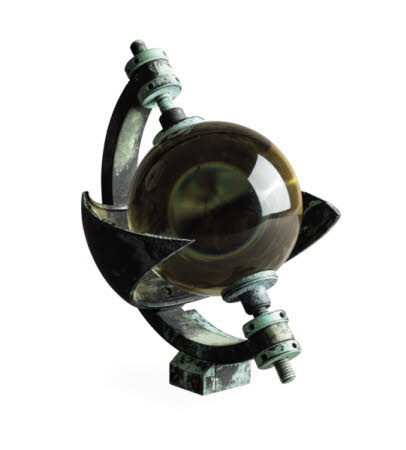Heliograph
Category
Objets de vertu
Date
c. 1880 - 1900
Materials
Brass, Glass
Measurements
280 mm (H)215 mm (W)
Order this imageCollection
Cragside, Northumberland
NT 1232014
Caption
This Grade II listed glass globe once recorded hours of sunshine in the gardens at Cragside. The metal-mounted glass sphere concentrates sunlight onto a strong card marked with the hours of the day. As the sun travels across the sky, the rays are concentrated on the card and leave scorch marks, a visible record of the amount and intensity of sunlight. The results help scientists to understand and monitor changes in climate and weather. This sunshine recorder – sometimes known as a heliograph – was made locally in Newcastle by instrument makers Brady & Martin. Cragside was home to inventor and engineer William, 1st Lord Armstrong (1810–1900). He was concerned about reliance on fossil fuels and interested in harnessing the power of the natural world, from hydroelectricity to the potential to use the sun’s rays to generate energy. In 1876 his Newcastle workshop manufactured parts for a similar heliograph that was installed at the Royal Observatory in Greenwich. Although sunshine recorders were developed in the 19th century, some are still used by meteorologists today. A replica sphere now stands in the garden at Cragside.
Summary
Heliograph / sunshine recorder, glass sphere with brass metal stand which screws on to circular base; curved metal shield holds trace cards in place to record hours of sunshine; this is the original from the garden and was mounted on a plinth there (replica is now at the gardens and is numbered CRA/V/3).
Provenance
Armstrong collection. Transferred by the Treasury to The National Trust in 1977 via the National Land Fund, aided by 3rd Baron Armstrong of Bamburgh and Cragside (1919 - 1987).
